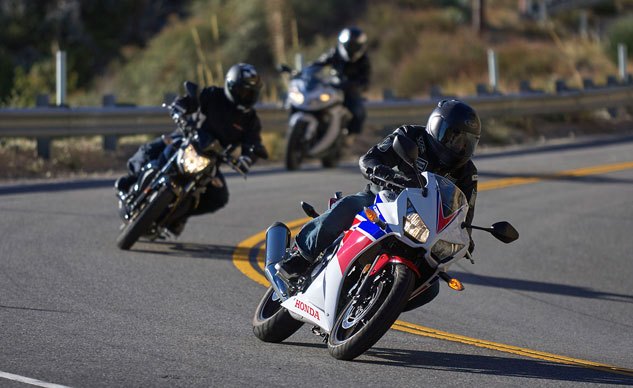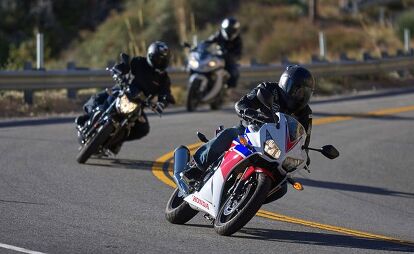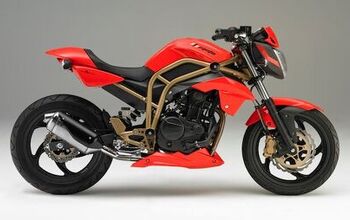Sub-300cc Sporty Bike Shootout + Video
Honda CBR300R vs. Kawasaki Ninja 300 vs. SYM Symfighter T2 250i
The Lightweight Nakeds Comparo we did last September was such a hoot we decided to do it again on a few more little thumper/screamers. Flying around sunny SoCal’s freeways and mountain roads like little white blood cells fighting pathogens and boredom in your cardiovascular system is what we do best, flitting from Starbucks to Starbucks, letting the lattes fall where they may.
The Honda CB300F came out on top of the last small heap, not too surprisingly, so we decided we needed to throw the new, fully faired CBR300R into the ring against the littlest Ninja – a classic Single vs Twin sporting matchup – which also gave us the chance to see how the recently discovered, made-in-Taiwan SYM T2 250i measures up against the best from Japan. The “Symfighter” belonged with the nakeds, really, but ours is not a perfect world. It’s close though. Consider this our sacrifice to help those of you experiencing the “wicked blizzahd” back east we’re hearing about on the interwebs.
SYM Symfighter T2 250i
The SYM T2 we recently reviewed is a nice enough little bike for zipping around down in the flatlands (unless your flatland is a mile high, like Denver or someplace). Everything works like it should – if not always with quite the well-oiled feel of the Honda and Kawasaki. Its fuel-injection mapping isn’t as refined as those bikes’, but on a 250 you’ve got the throttle pretty much WFO most of the time, anyway, so it’s less of an issue. Though two of the bikes here may look sportier than the SYM since they wear full fairings and it does not, all three, in fact, share standard, upright ergonomics that make it easy and fun to be fully in control while maneuvering through the four-wheeled moving obstacle course. At 385 pounds, the SYM weighs almost exactly the same as the Ninja, and 25 pounds more than the Honda. They’re all light, easy-to-handle little bikes.
If all you want is urban transpo, the Symfighter’s got you covered. But it’s our job to leave civilization behind and head up Highway 39 into the San Gabriels. No more macchiato for you. Actually, they make a mean Frito pie up at Crystal Lake Cafe … let’s ride.
You don’t want to eat too heavy a breakfast on the SYM until you’re on top of the mountain. Once the road climbs past the 2000-feet sign, there’s a long straight that makes you painfully aware you’re on a small bike, and the pain is most acute if you’re on the SYM. Its claimed 25 horsepower feels like around 21 or 22 at the rear wheel. The Ninja’s 34 hp – 50% more – waves sayonara to the SYM, whose top speed at altitude is much less than the 93 its speedo says it can generate, eventually, down closer to sea level. When it’s running at freeway speeds, though, especially on rain-grooved ones, the SYM front end feels a bit nervous. A few more mm of trail feels as if it wouldn’t be a bad thing.
We put our new BFF, Thai Long Ly on the SYM for the climb up the mountain: “She seemed solid until the revs started climbing and the bike started wetting itself. Not in a leaky I-need-a-diaper kind of way, but in an oh God, please stop with the throttle thing and let me cruise with the Harley crowd kind of way. In other words, I’ll catch up … I’ll meet you at the top. Disappointing, because as you twist, she goes. As you keep twisting, she goes not. The canyon that opened when the drag race up the mountain ensued was quite grand. And quite immediate. Giving her the beans, she sounded like a Ducati with a collapsed lung being kicked to the ground by Ronaldo.”
We’d like to tell you the Symfighter’s handling makes up for its lack of pep, but it doesn’t. What the Big Four have that companies like SYM seem to lack are really good test riders and tuners who are able to calibrate even inexpensive suspension to work reasonably well. Due to its lack of power and light weight, the SYM’s a lot of fun to ride on swervy roads all the same, but it lacks the final 20-30% of composure of the Honda and the Ninja. Even with its weakish front brake, you can still decel hard enough to get its fork chattering. When you really start riding, the Symfighter’s less precise gearbox, lack of power and un-optimal suspension tune mean it has a hard time keeping up.
SYM Symfighter T2 250i
+ Highs
- Actually looks pretty cool
- Least $$$
- A big step up from Chinese bikes
– Sighs
- The competition here is a little too tough
- More show than go
- The CBR (or CB300F) is not much more money
Honda CBR300R
The Honda CBR300R is more like it: 26 hp still isn’t much, but the Honda also left the SYM in its dust on the way up Highway 39. The CBR’s also got just as much torque as the Kawasaki at 2900 fewer rpm, which actually makes it a little easier to zot around upon if you’re a rank beginner or a lazy old guy. The fact that the Honda is 25 pounds lighter than the other two bikes doesn’t hurt it, and lets it cling to the Ninja’s tailsection on roads where there are no straights: Completely standard ergonomics that seem to fit everybody very well, typically transparent Honda controls, willing engine (up to a point) and gearbox, balanced suspension, probably the strongest brakes here – the only thing holding the CBR back in sporting use is its lack of horsepower.
Not in sporting use, the Honda is even harder to fault. Where you need a big twist of throttle to get the Ninja revved up and moving, it’s easier to dump the little Honda’s clutch at lower rpm and thump on off. Once you get used to the tach needle being 1500 rpm from redline for miles on end, it’s no problem to keep up your usual freeway pace (mine seems to settle around 85 mph no matter what I’m riding/driving), and at that speed the R version sails along even smoother and more relaxatorily than the naked CB300F, thanks to its fairing and windscreen, as well as faultless stability. T. Roderick agrees the little CBR offers the most expansive and comfy cockpit of the trio.
If it’s not quite the equal of the Ninja as a full-on sportbike, it’s a much closer contest when slicing up urban traffic. The Honda squeezes through the skinniest traffic gaps with the greatest of ease, deals with busted-up pavement like a honey badger, and just gets on with it at well over 60 mpg in commuter mode, all the while needing a little less throttle-twisting than the Ninja to get motivating.
Still, a little more power would be nice. The world according to Thai: “It’s a nice little bike, but I’d like a bit more poop, and the CBR poops out far too quickly for my tastes. She pulls nicely off the line and gets moving in a respectable manner … she just runs out of steam once the fun starts and you find yourself pulling the lever for satisfaction. Sort of like the attractive girl you’ve been flirting all night with at the Christmas party that finally lets you in, only to pass out drunk the moment her head hits the pillow.”
No means no.
Honda CBR300R
+ Highs
- #1 for urbane assault
- Feels like it will last longer than you will
- Defines user friendly
– Sighs
- How about a 400cc Single for the U.S. market?
- A bit buzzy to some at freeway velocity
- Don’t get much chance to take advantage of low gas prices
Winner: Kawasaki Ninja 300
The extra 47cc Kawasaki gave the Ninja two seasons ago, via a longer stroke, may be the best 47cc a moto manufacturer ever spent. Modern EFI no doubt contributed another big portion of the little Twin’s newfound performance, resulting in a diminutive motorcycle that’ll exceed 100 mph with relative ease (not that you ever should!) and pull away from the other two bikes here without breaking a sweat. It also fattened the rest of the powerband all the way from idle on up.
“The fact that the further thou twisteth the throttle, the faster thou goest, puts this bike firmly in front of the others in this comparo. Where the CBR and SYM poop out, the Ninjette keeps pooping. Rich and cream-like,” sayeth Thai Long Ly, who liked just about everything else about the Ninja equally well: “The Ninja was smooth as butter, churning out a velvety delivery at speeds that’d be classified as “reckless driving” under the California penal code. Having a redline north of 14k (actually it turns red at 13k – Ed.) helps the baby Ninja feel the most sporty of the bunch, and the more composed suspension makes this bike a total hoot to whip around any corner at most sane speeds. I’d say it’s worth the extra cash over the others, and this bike gets my highest recommendation for new riders looking to stay in control of their bikes when leaned over as well as composed when splitting traffic on the freeway.”
Tom Roderick concurs: “The Ninja feels most like a full-size bike with an inline-four engine. The Kawi’s parallel-Twin spins up revs quickly, and for a small-displacement motorcycle, delivers a wide powerband that easily outpaces both the SYM and Honda in any kind of acceleration comparison. Another area where the Ninja’s price tag seems deserved is in its suspension. Very supple on the freeway while providing composure in the twisties. Its seat-to-footpeg ratio is tighter than on the Honda, but all its other qualities outweigh that drawback.”
We all whined that the Ninja’s brakes felt a bit wooden and underpowered; mostly because it generates speed so much more easily than the other two bikes. After getting any of these three bikes’ brakes nice and warm, you’ll pull the lever all the way back onto your ring and pinkie fingers before you’ll lock the front tire. The Ninja suspension can be a bit harsh on sharp bumps, but on smooth twisty pavement, this one lives up to its Ninja heritage, with firm yet supple, balanced damping that lets you get on with riding like a maniac.
I could do with a quicker-opening throttle, personally, because the Ninja likes plenty of revs for best progress. Aside from that, there’s little to complain about except that the Ninja’s the priciest bike here. This is the one you’re going to outgrow the least quickly, though, and if you’re an experienced rider just looking to downsize/simplify, it’s the one bike of these that’s really doable as a daily driver if you routinely travel more than 20 or 30 miles at a time.
Kawasaki Ninja 300
+ Highs
- Looks swoopy, rides like a comfy standard
- 34 hp feels like almost enough
- A good rider on this David can slaymany Goliaths
– Sighs
- Biggest price tag
- A better front brake would be nice
- You’ll be tempted to “overimprove” itwith expensive upgrades
Small Elephants in the Room
The elephants in the room are the new KTM RC390 and the Duke 390, scheduled to be here soon – both big Singles with enough displacement to really challenge the Ninja – and don’t forget the new Yamaha R3, a 320cc Twin aimed squarely at it. We love a good arms escalation!
Sub-300cc Sporty Bike Shootout Scorecard | |||
| Category | Honda CBR300R | Kawasaki Ninja 300 | SYM T2 250i |
|---|---|---|---|
| Price | 86.4% | 76.0% | 100% |
| Weight | 100% | 93.3% | 93.3% |
| lb/hp | 82.5% | 100% | 64.6% |
| lb/lb-ft | 100% | 93.6% | 81.8% |
| Engine | 80.0% | 91.3% | 68.3% |
| Transmission/Clutch | 78.3% | 85.8% | 64.2% |
| Handling | 80.0% | 90.0% | 63.3% |
| Brakes | 75.0% | 73.3% | 70.8% |
| Suspension | 73.3% | 83.3% | 66.7% |
| Technologies | 75.0% | 76.7% | 73.3% |
| Instruments | 80.0% | 81.7% | 78.3% |
| Ergonomics/Comfort | 81.7% | 78.3% | 63.3% |
| Quality, Fit & Finish | 81.7% | 83.3% | 78.3% |
| Cool Factor | 77.5% | 81.7% | 71.7% |
| Grin Factor | 75.0% | 81.7% | 63.3% |
| Overall Score | 81.0% | 84.3% | 73.1% |
Sub-300cc Sporty Bike Shootout Specs | |||
| Honda CBR300R | Kawasaki Ninja 300 | SYM T2 250i | |
| MSRP | $4,399 (ABS: $4,899) | $4,999 (ABS: $5,299) | $3,799 |
| Engine Type | 286cc liquid-cooled single-cylinder four-stroke | 296cc Four-stroke, liquid-cooled, parallel-Twin | 249cc Four-stroke liquid-cooled Single |
| Bore and Stroke | 76.0 x 63.0 mm | 62.0 x 49.0mm | N/A |
| Fuel System | PGM-FI 38mm Throttle Body | DFI with dual 32mm throttle bodies | EFI |
| Ignition | Computer-controlled digital transistorized with electronic advance | TCBI with digital advance | CDI |
| Compression Ratio | 10.7:1 | 10.6:1 | 10.5:1 |
| Valve Train | DOHC; 4 valves per cylinder | DOHC; 4 valves per cylinder | SOHC; 4 valves per cylinder |
| Emissions | EPA, CARB compliant | EPA, CARB-compliant | EPA & DOT Approved, C.A.R.B. Approved for CA |
| Horsepower | 26.2 @ 8500 rpm | 34.0 @ 11,000 rpm | approx. 22 @ 7500 rpm |
| Torque | 17.4 @ 6800 rpm | 17.5 @ 9700 rpm | approx. 15.3 @ 6000 rpm |
| Transmission | 6-speed; multi-plate wet clutch | 6-speed, multi-plate wet clutch, positive neutral finder | 6-speed, wet disc type |
| Final Drive | Chain | Chain | Chain |
| Front Suspension | 37mm fork; 4.65 in. travel | 37mm hydraulic telescopic fork / 4.7 in | Telescopic Fork |
| Rear Suspension | Pro-Link single shock with five positions of spring preload adjustability; 4.07 inches travel | Uni-Trak with 5-way adjustable preload / 5.2 in | Uni Swing |
| Front Brake | Single 296mm disc; 2-piston calipers, ABS optional | Single 290mm petal-type disc with two-piston hydraulic caliper, ABS optional | Disc (288mm) |
| Rear Brake | Single 220mm disc; single-piston caliper | Single 220mm petal-type disc with two-piston hydraulic caliper, ABS optional | Disc (222mm) |
| Front Tire | 110/70-17 | 110/70-17 | 110/70 – 17 |
| Rear Tire | 140/70-17 | 140/70-17 | 140/70-17 |
| Rake/Trail | 25.3° / 3.85 in. (98.0mm) | 27° / 3.7 in. (94.0mm) | |
| Wheelbase | 54.3 in. | 55.3 in. | 51.9 in. |
| Seat Height | 30.7 in. | 30.9 in. | 31.0 in. |
| Curb Weight | 360 | 385 | 385 |
| Fuel Capacity | 3.4 gal. | 4.5 gal. | 3.7 gal. |
| Tested Fuel Economy | 57 | 49 | 63 mpg |
| Available Colors | Black, Red, Pearl White/Red/Blue, Matte Black Metallic/Yellow | Lime Green, Pearl Stardust White | Midnight Black, Racing White, Intense Yellow |
| Warranty | One year, Transferable, unlimited-mileage limited warranty; extended coverage available with a Honda Protection Plan. | One year limited warranty | 24 Months Limited Warranty |
More by John Burns









































































































Comments
Join the conversation
This looks like fun. Ninja 250 with a 600 Rotax single shoehorned in it ;)
Thanks for the comparison. I owned a 300cc Ninja for a year or so and loved it. Sold it when I moved to Europe. Definitely want to see a Ninja vs. KTM vs. R3 shootout. Don't make us wait too long.